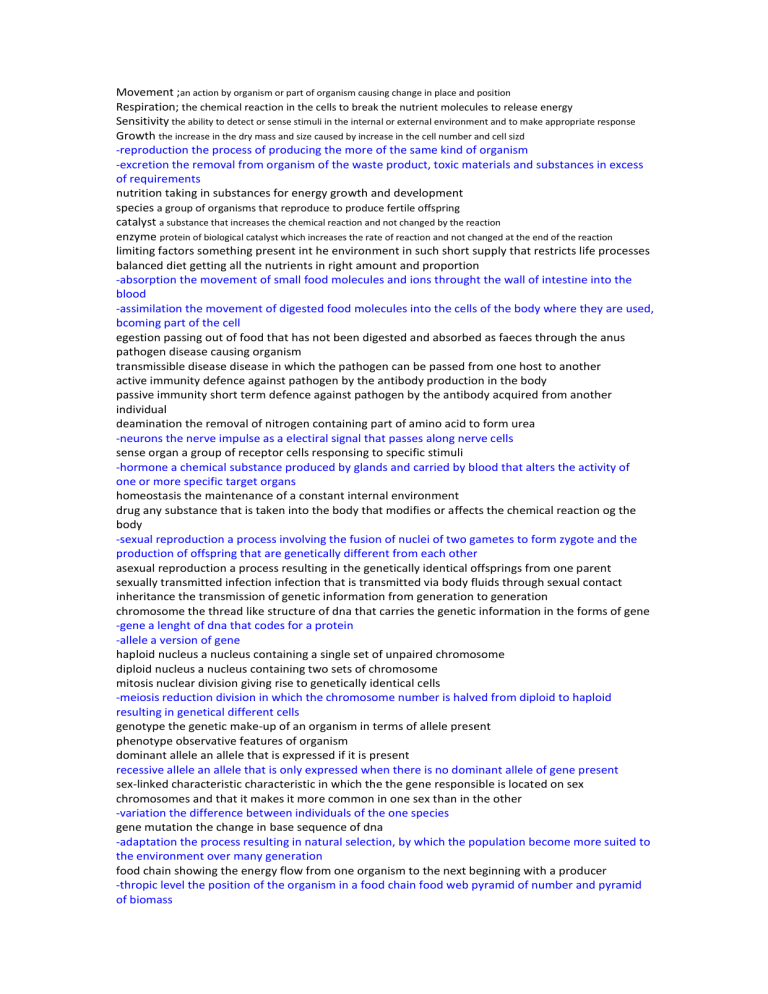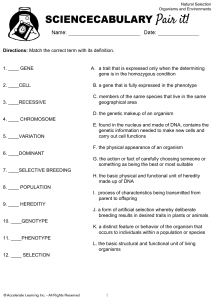
Movement ;an action by organism or part of organism causing change in place and position Respiration; the chemical reaction in the cells to break the nutrient molecules to release energy Sensitivity the ability to detect or sense stimuli in the internal or external environment and to make appropriate response Growth the increase in the dry mass and size caused by increase in the cell number and cell sizd -reproduction the process of producing the more of the same kind of organism -excretion the removal from organism of the waste product, toxic materials and substances in excess of requirements nutrition taking in substances for energy growth and development species a group of organisms that reproduce to produce fertile offspring catalyst a substance that increases the chemical reaction and not changed by the reaction enzyme protein of biological catalyst which increases the rate of reaction and not changed at the end of the reaction limiting factors something present int he environment in such short supply that restricts life processes balanced diet getting all the nutrients in right amount and proportion -absorption the movement of small food molecules and ions throught the wall of intestine into the blood -assimilation the movement of digested food molecules into the cells of the body where they are used, bcoming part of the cell egestion passing out of food that has not been digested and absorbed as faeces through the anus pathogen disease causing organism transmissible disease disease in which the pathogen can be passed from one host to another active immunity defence against pathogen by the antibody production in the body passive immunity short term defence against pathogen by the antibody acquired from another individual deamination the removal of nitrogen containing part of amino acid to form urea -neurons the nerve impulse as a electiral signal that passes along nerve cells sense organ a group of receptor cells responsing to specific stimuli -hormone a chemical substance produced by glands and carried by blood that alters the activity of one or more specific target organs homeostasis the maintenance of a constant internal environment drug any substance that is taken into the body that modifies or affects the chemical reaction og the body -sexual reproduction a process involving the fusion of nuclei of two gametes to form zygote and the production of offspring that are genetically different from each other asexual reproduction a process resulting in the genetically identical offsprings from one parent sexually transmitted infection infection that is transmitted via body fluids through sexual contact inheritance the transmission of genetic information from generation to generation chromosome the thread like structure of dna that carries the genetic information in the forms of gene -gene a lenght of dna that codes for a protein -allele a version of gene haploid nucleus a nucleus containing a single set of unpaired chromosome diploid nucleus a nucleus containing two sets of chromosome mitosis nuclear division giving rise to genetically identical cells -meiosis reduction division in which the chromosome number is halved from diploid to haploid resulting in genetical different cells genotype the genetic make-up of an organism in terms of allele present phenotype observative features of organism dominant allele an allele that is expressed if it is present recessive allele an allele that is only expressed when there is no dominant allele of gene present sex-linked characteristic characteristic in which the the gene responsible is located on sex chromosomes and that it makes it more common in one sex than in the other -variation the difference between individuals of the one species gene mutation the change in base sequence of dna -adaptation the process resulting in natural selection, by which the population become more suited to the environment over many generation food chain showing the energy flow from one organism to the next beginning with a producer -thropic level the position of the organism in a food chain food web pyramid of number and pyramid of biomass -food web the network of interconnected food chains decomposer the organism which gets its energy from dead and waste organic material community ecosystem genetic engineering sustainable development starch reducing sugar protein lipid DNA structurecholera


